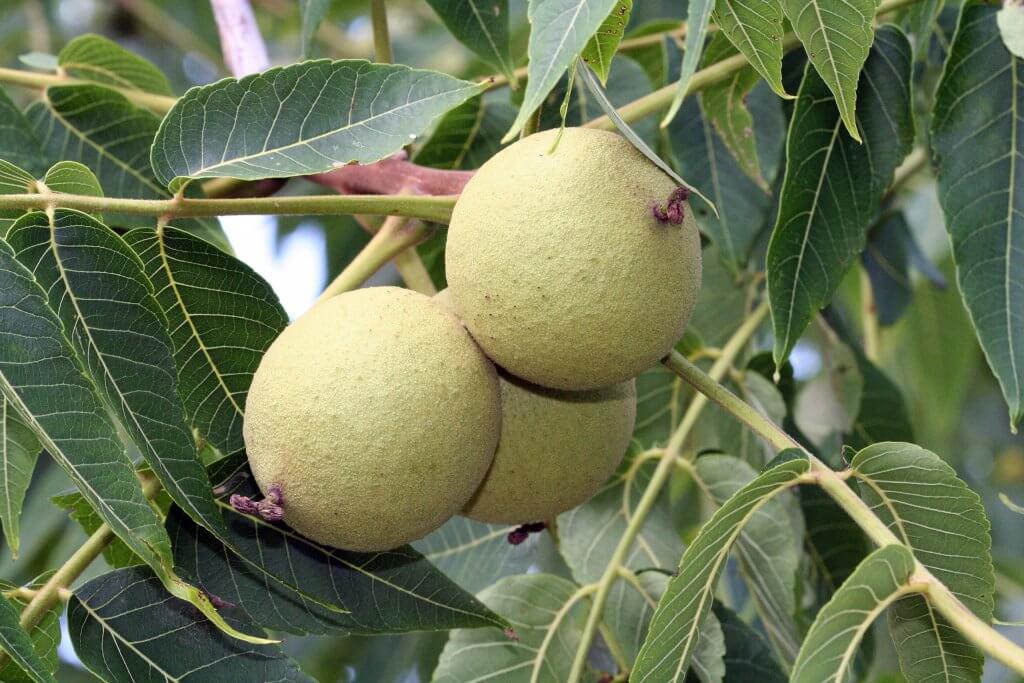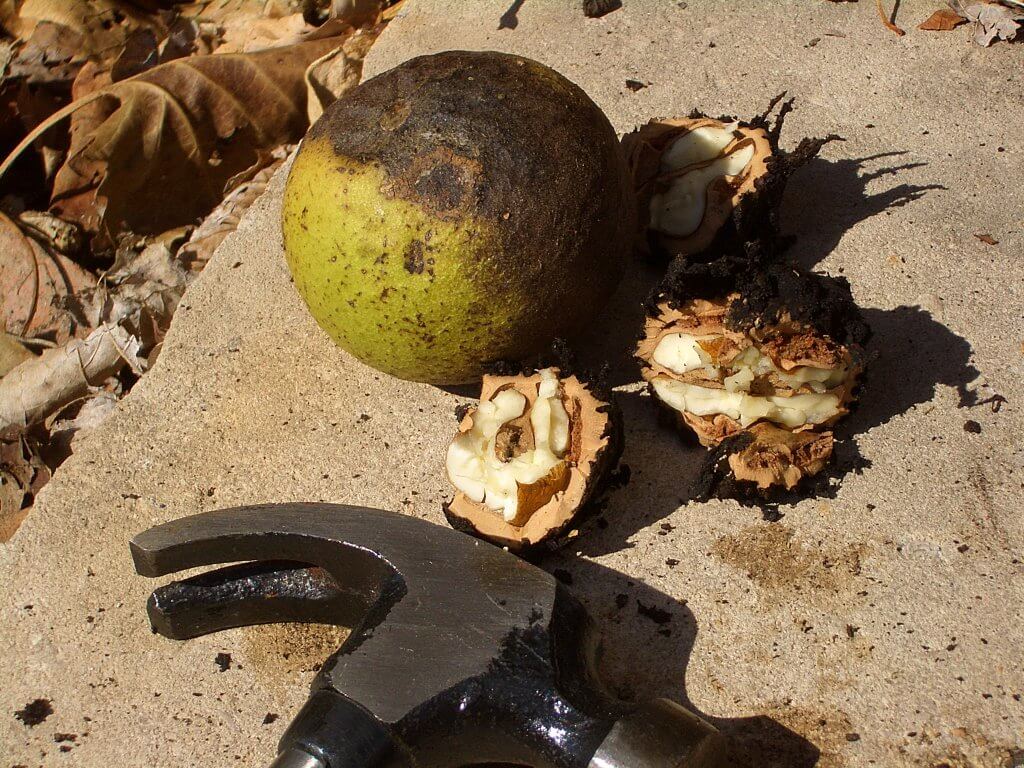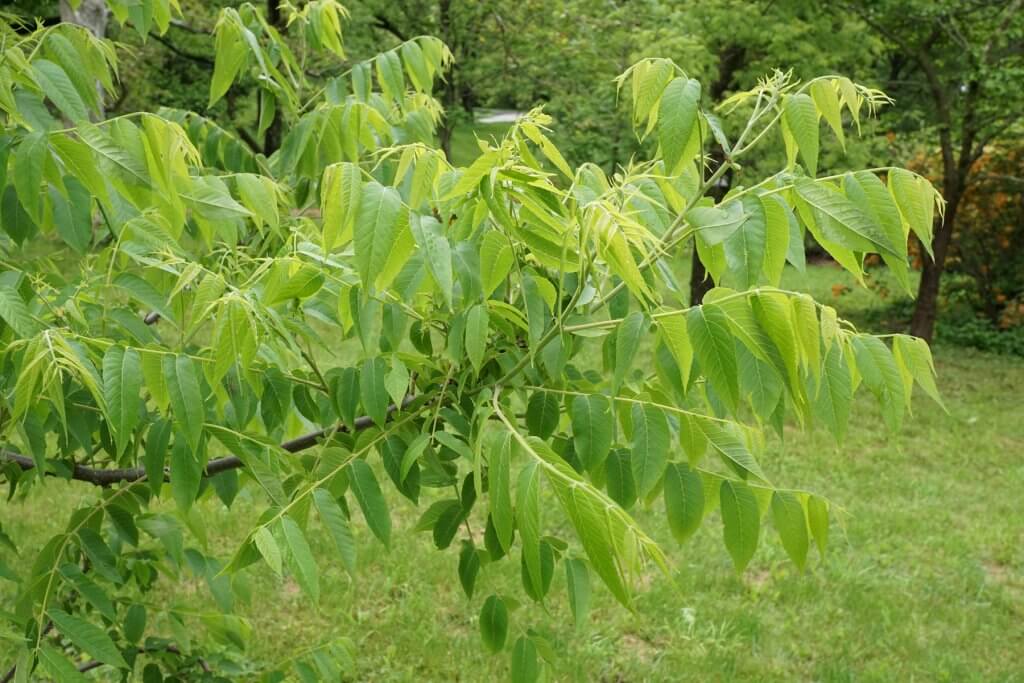Black walnut (Juglans nigra), is a deciduous tree that can be found throughout the eastern, and midwestern states. Valued for its wood and the coveted walnuts, black walnut trees are a pioneer species that are fairly prolific in the wild. They are often cultivated for their wood and nuts simultaneously. Trading the wood gives growers a second guaranteed income when the fruit production can be irregular.
Reaching towering heights of up to 35m in forested areas where it competes for sunlight, the long dark, trunk bears a diamond shaped pattern. The leaves are compound and pinnate, with a short almost palm like appearance. The individual leaflets are lightly serrated, and will produce an earthy, spiced smell when crushed. The leaves are also noticeably smaller on the black walnut species, compared to the European common walnut (Juglans regia).

The fruits develop from female flowers, pollinated by the male catkins. Small green fruits, resembling a plum start to ripen throughout the summer. Each one containing the coveted brown nut within its fleshy husk. Yields vary year to year, with some trees only producing great yields of walnuts every other year.
Edible parts and other uses
Black walnuts can be used and substituted into any recipes that calls for walnuts. A popular sweet treat are black walnut cookies, however they can also be used in pies tarts and even ice cream. Only the nuts are considered edible. However the black walnut tree can also be tapped like a maple, to extract a sweet sap that can be processed to form black walnut syrup.
To open a walnut fruit simply run a sharp knife right around the middle, then twist each cut half in opposite directions and pull to remove. The nuts within can then be washed and dried in the sun for several hours. They can then be stored in meshed or netted bags to be cured for a minimum of two weeks. The nut shell should now be much easier to crack. A hammer, vice or nut cracker can then be used to remove the nut within.

Almost as valuable as the nuts, the wood of the black walnut tree is highly sought after. Its dark coloring and malleability making it a popular choice for high end furniture and flooring.
Native Americans have used the black walnut tree for generations, as a source of food and as a herbal medicine. The hulls were often used to expel intestinal worms and parasites from their dogs and livestock. The bark would also be used to create a concoction that soothed general aches and pains.
Cautions
When cracking a great number of nuts it is advisable to wear protective glasses to shield you from any stray pieces of the casing. The outer husks also contain a high concentration of tannins which can stain clothing, driveways and even skin. In fact early European settlers would extract a dye from black walnuts to dye their hair.
Foraging
Look for black walnut trees in full sun in areas near the banks of rivers or creeks. It may likely be standing alone without much surrounding greenery due to the fact that its roots release chemicals which can stunt or inhibit the growth of other plants. They can often be found growing close to populations of hackberry and ash.
The walnuts can be collected from early autumn. When fully ripened in October they will fall from the trees, so a gentle nudge to the lower branches can help to dislodge a few extra nuts.

Did you know…
Black walnut trees are so valuable that criminality in the form of walnut poaching has now emerged. In one instance DNA testing was actually carried out to trace the origin of a suspected stolen tree.
Conclusion
A highly valued tree, black walnut is a fantastic wild edible to forage during a crisp autumnal walk. The recognisable nutty flavoring can add an earthy and sweet depth to seasonal cakes and halloween cookies.
—————Written by Hannah Sweet
Hannah is a freelance writer and graphic designer from the UK. With a penchant for travelling, photography and all things botanical, she enjoys writing about a wealth of topics and issues, from conservation and slow living, to design and travel. Learn more about her writing and design services at www.sweetmeanders.co
Many of our readers find that subscribing to Eat The Planet is the best way to make sure they don't miss any of our valuable information about wild edibles.
See our privacy policy for more information about ads on this site






